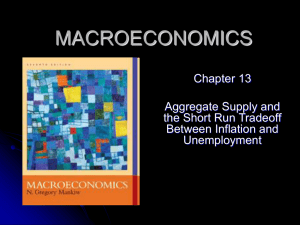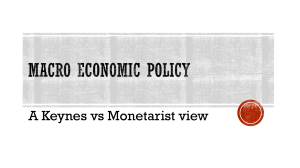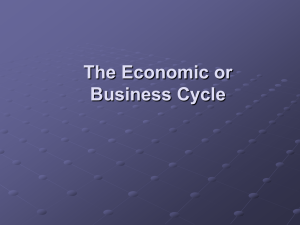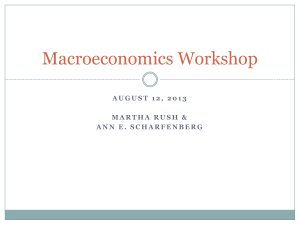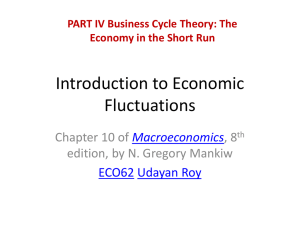Preparing_for_the_AS_Economics_Macro_Paper
advertisement
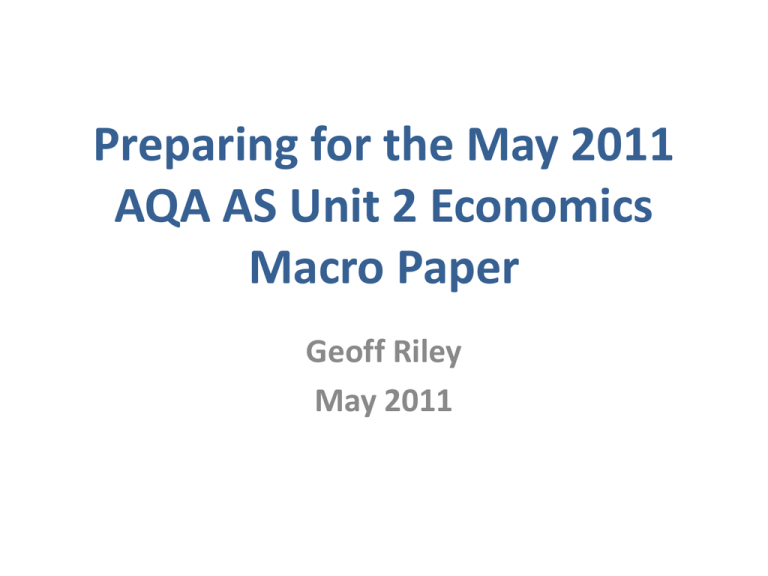
Preparing for the May 2011 AQA AS Unit 2 Economics Macro Paper Geoff Riley May 2011 Recent AQA Unit 2 Papers • • • • • January 2009: – Productivity growth and importance for macro performance – Household savings and importance for macro performance June 2009: – Inflation and monetary policy, Inflation and AD – Growth and consumption January 2010: – Exchange rate, Balance of Payments – Economic cycle and unemployment June 2010: – Causes and consequences of a fall in investment spending – Economies in recession, policies to help the UK recover from recession January 2011: – Demand and supply side policies to generate higher economic growth – Role of fiscal and monetary policy in maintaining economic stability Some possibilities for May 2011 • Causes of economic recovery, stimulus policies and multiplier/accelerator • Why is inflation persistently above target, achieving growth without inflation • Demand and supply-side shocks including oil & food prices • Difficulties in achieving macro aims (policy “trade-offs”) • Output gap, unemployment and inflation / deflation • Saving and consumer spending and real disposable incomes • Demand and supply-side causes of unemployment • Demand and supply-side policies to reduce unemployment • Policies to improve balance of payments in recent years (current account only) • Interest rates & their impact on the macro-economy / credit supply and cost • Cuts in government spending and their possible economic effects • Changes in the exchange rate and their macro impact (AD and SRAS) Reminder about timing • 75 minute paper • 25 Q multiple choice paper – 20 mins • Data response question – (1) Key term definition (5 marks) – 2 min – (2) Data description (8 marks) – 5 min – (3) Explanation question (12 marks) – 15 min – (4) Evaluation question (25 marks) – 30 min What is core? • Determinants of macroeconomic performance – Understanding of AD-AS analysis – Using this analysis to explore recent and current economic behaviour and events • Analysing and critically evaluating a range of macroeconomic policies (e.g. MP, FP and SS-P) – How do policies work? The transmission mechanism – What are the limitations / constraints of each policy? • Understanding the external environment and how it impacts on the British economy • Being aware of how the different macroeconomic topics link together e.g. Inflation and unemployment Macroeconomic performance and stability • Domestic objectives: – – – – GDP: Real economic growth (short and long term) CPI: Price stability (low stable positive inflation) Achieving higher employment / less unemployment Higher living standards (i.e. GDP per capita and other measures of well-being and social welfare) • External objectives – Sustainable position on the current account of the BoP – Maintaining competitiveness in the global economy • Restoring and then maintaining economic stability – Smoothing some of the volatility in key macro objectives such as inflation, growth and unemployment Trying to achieve macro stability The output gap is negative Oil prices affect AD and SRAS Jobs and prices Trend growth is falling – why? How much borrowing can the UK take? Govt Spending has macro & micro effects Taxes also have microeconomic effects! UK exposed to external demand shocks 1. A big rise or fall in the exchange rate 2. Recession in major trading partners which affects the demand for exports 3. A prolonged slump in the housing market 4. The credit crunch – squeezing the supply of loans – impact on businesses and consumers 5. Unexpected (large) changes in interest rates or taxes A fall in aggregate demand Price Level An initial change in AD can have a much greater final impact on equilibrium national income. This is known as the multiplier effect LRAS AD2 AD1 SRAS Y1 Y2 Real National Output Supply-side shocks • Supply side can be affected by shock effects • Some of these are negative for growth and inflation – other supply-side shocks can have a positive impact • SRAS: – – – – Changes in global food prices Volatility in the prices of imported raw materials / energy Changes in import tariffs and other import controls Changes in indirect taxes on businesses and subsidies • LRAS – Impact of new technologies on costs and productivity – Long term impact of innovation and invention – Unexpected changes in the size of net labour migration A fall in short run aggregate supply Price Level A fall in SRAS might be caused by higher costs of production – leading to lower supply at each price level LRAS SRAS2 SRAS1 AD1 Y2 National Output Y1 Yfc An increase in productive potential Price Level An increase in the supply-side capacity of the economy is shown by shift in LRAS LRAS LRAS2 AD1 SRAS1 Y1 National Output Yfc Yfc2 Macro Evaluation (1) 1. Most macro problems have multiple causes 2. No single macro policy works in isolation 3. Combination of policies needed for short & longer term 1. 2. Demand side policies and supply side policies Be clear on the main ideas behind Keynesian macro theory 4. Remember – economics is a social science – we can never be certain about how people will respond 5. Expectations and confidence are crucial – e.g. Weak animal spirits during the early stages of a recovery 6. Policy time lags are uncertain e.g. The time lag between economic recovery and falling unemployment 7. Use data to support or reject a point of view 8. Question reliability of the data – especially if out of date Macro Evaluation (2) • Importance of macro awareness / knowledge 1. 2. 3. • • • It is crucial that you show an awareness of what is actually happening in the British economy Use extracts in your answer to Q (3) – make at least three explicit data references in your final answer (from charts, table and text) Also show awareness of events / issues in other countries – useful for comparative illustrations e.g. Events in the USA, Europe, China AD-AS analysis must always be used as foundation to show impact on output, prices, employment The UK is an open economy vulnerable to external events Remember to offer a clear final conclusion in the 25 mark Q – this is essential to get a level 5 answer in the 25 marker Evaluation phrases • • • • • • • • • However Hence Nevertheless Although It is likely that With the benefit of hindsight On the other hand In the short run …….. but in the long run It depends upon (e.g. price elasticity of demand, what happens to the exchange rate, etc.) • The data suggest that ... But the data in the extract is out of date • According to the article the writer argues that …… but Remember the Wee-Steps Approach W Wider context – consider the bigger picture in an issue and use it to weight your arguments E Efficiency – Does this achieve a more/less efficient allocation of resources? E Equality – Do some parties benefit more/less than others from a policy change? S Scope – How many people are affected by the point? Is it wide reaching or narrow? T Time – How long will it last, SR or LR or both? E Effectiveness – does it solve the issue it was intended to solve? Are there better alternatives? P Prioritisation – which of your points is the strongest and why. Be specific about the context of the question – use this in your final paragraph S Scale or Magnitude – where people are affected how strong is the impact? UK economy at a glance % change unless stated 2009 2010 2011 Consumer spending -3.3 1.3 -0.5 Government consumption 1.0 1.2 -1.0 Investment -15.4 3.5 5.5 Stock-building (% GDP) -1.2 0.1 0.5 Domestic demand -5.5 2.7 0.8 Exports -10.1 5.3 6.5 Imports -11.9 8.0 3.5 GDP -4.9 1.7 1.5 At a glance (2) % change unless stated 2009 2010 2011 Manufacturing output -10.7 3.8 4.0 Company profits -7.5 1.0 3.0 Unemployment LFS measure (%) 7.6 7.9 8.6 Unemployment CC measure (%) 4.9 4.8 5.3 Average earnings (inc. Bonuses -0.1 2.2 1.0 RPI Inflation -0.5 4.5 3.2 CPI Inflation 2.1 3.3 3.2 Productivity (output per worker) -3.5 1.5 1.7 At a glance (3) % change unless stated 2009 2010 2011 BoP Current Account Balance (% GDP) -1.7 -2.3 -2.0 Government Budget (Fiscal) Balance (% GDP) -11.8 -10.1 -7.7 Gross government debt (% of GDP) 71.3 77.9 82.6 $1.62 $1.55 $1.40 Euro 1.13 Euro 1.19 Euro 1.22 0.5 0.5 0.50 10-year UK government bond yield (%) 4.1 3.7 2.75 World economic growth -0.8 4.5 3.5 US Dollar /£ exchange rate (annual average) Sterling / Euro exchange rate (annual average) Monetary policy: Base (policy) interest rate (%)



